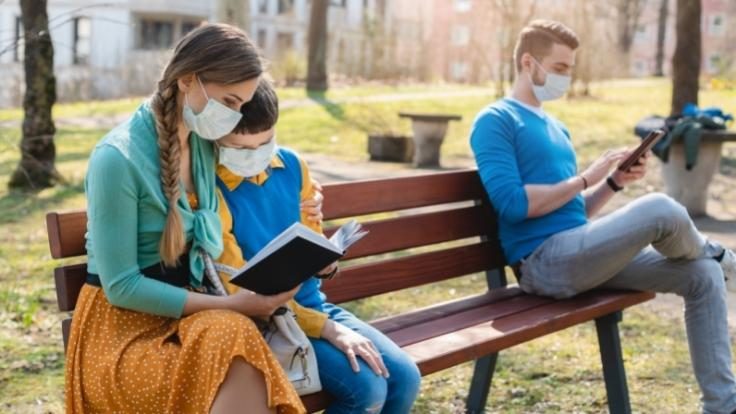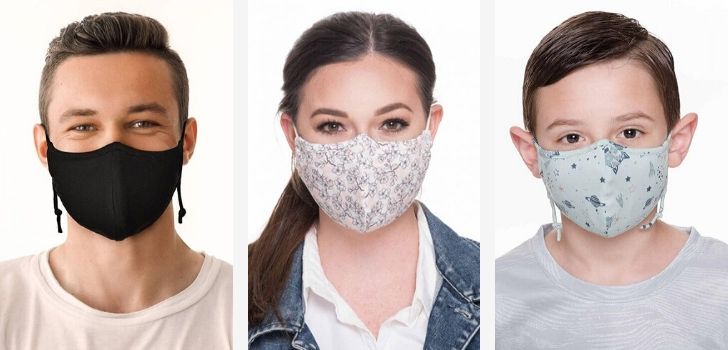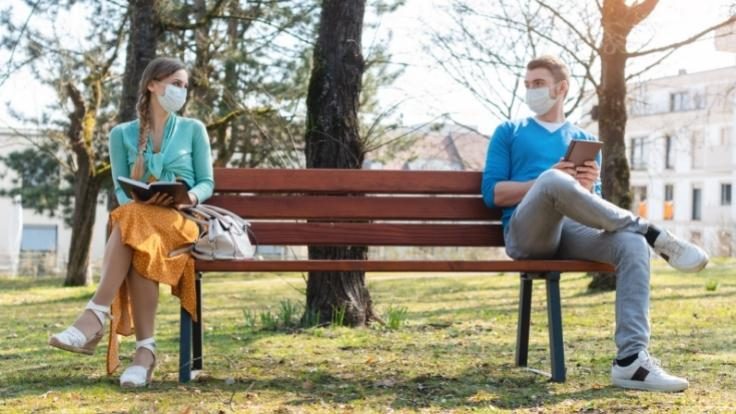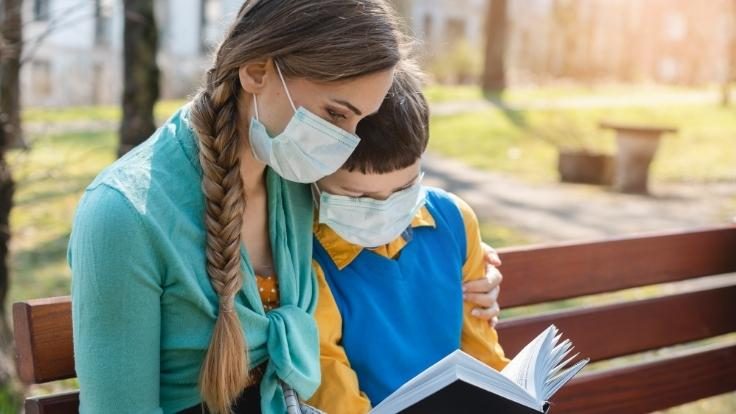As a new virus spreads around the world, new words and phrases enter our vocabulary. Things like “flatten the curve” and “social distancing.” The viral outbreak created an urgent need for ways to slow the spread of disease.
Coronavirus disease 2019 (COVID-19) is a big deal. It spreads faster than the flu and is more dangerous, too. This new virus can cause a severe lung infection. It can lead to pneumonia, respiratory failure, septic shock, and death.
Last month, the World Health Organization (WHO) declared a worldwide COVID pandemic. There is no approved vaccine or treatment for the virus – yet. But there ARE ways to limit your exposure to the virus and slow the spread of disease.
Reducing contact with people is the best way to slow the spread of the coronavirus. In this post, I’ll share ten ways to keep your family safe as you stay at home and practice social distancing.
Let’s get started.
📋 DISCLOSURE – This page has affiliate links. If you buy something through one of these links, I may earn a commission at no cost to you. Read more here.
What is Social Distancing?
Limiting face-to-face contact with people is the best way to reduce the spread of the new virus. The Centers for Disease Control and Prevention (CDC) recommends the following practices:
- Social Distancing – This means keeping a safe distance (about six feet) from people who are not related to you. It involves staying away from public gathering places like restaurants, schools, and churches.
- Quarantine – This involves keeping someone who might have the virus away from other people. Those who are in quarantine stay separated from others, even at home.
- Isolation – This separates sick people from healthy people. It’s a precautionary measure to protect healthy people from those with COVID-19 symptoms.
️🟦 SOCIAL TRENDS – #StayHomeStaySafe #ThisIsNotForever #TogetherAtHome

10 Ways to Protect Your Family
If social distancing is something new for your family, it can be hard to put into practice. Here are ten tips to help you keep your family safe during the pandemic. Please share YOUR tips in the comments section below.
📋 DISCLAIMER – Savoring Home does not provide health or medical advice, diagnosis, or treatment. The content on this website is for information only.
1. Limit News Exposure
It’s important to get accurate and timely health information about COVID-19. The National Coronavirus Task Force updates the public with daily briefings. But too much exposure to news coverage can lead to fear and anxiety.
Are you and your family glued to the television these days? Balance the time you spend on the news with activities unrelated to the virus. Read a book, listen to music, or play a board game together.
- Centers for Disease Control and Prevention
- National Coronavirus Task Force
- World Health Organization
2. Clean and Disinfect
This second tip is a practical one that involves housekeeping. The CDC recommends that you clean AND disinfect your home daily during the pandemic. Or any time someone is sick.
Do you know the difference between cleaning, sanitizing, and disinfecting?
Cleaning gets rid of dirt and grime where germs can grow. It removes most surface germs – which is adequate for most homes, most of the time. Use soap and water, or a gentle cleaning agent, to wipe down surfaces you and your family touch often.
Sanitizing kills most surface germs like bacteria, fungi, and viruses. It reduces them by 99.9 percent or more. Make sure you sanitize ALL surfaces you and your family touch often. Pay close attention to your food preparation areas.
Disinfecting kills or inactivates almost all surface germs. During the pandemic, the CDC recommends that you disinfect your home after you clean it. Use a household disinfectant, diluted bleach, or a 70 percent alcohol solution.
Disinfect or Sanitize?
“Wait,” you might say. The definitions for disinfecting and sanitizing sound similar. So, should you disinfect your home, sanitize it, or both? In practice, the difference boils down to semantics. The important thing is that you clean AND disinfect/sanitize the surface areas on a daily basis.
For hard surfaces, think of what you and your family touch every day. Tables, desks, kitchen counters, doorknobs, handles, light switches, phones, keyboards, sinks, bathroom fixtures. Clean them first, then follow up with a sanitizer or disinfectant.
For soft surfaces like carpets, rugs, and drapes, use an appropriate cleaner – or soap and water – on spots and spills. Launder clothes, towels, and linens using the warmest appropriate water setting. Follow up with a disinfectant spray.
3. Create Daily Routines
Home life is different when you practice social distancing. You can help your family adjust to the change by creating new routines. According to QED/MindShift, kids need the world to be predictable more than they need it to be pleasant all the time.
Many parents lost their routines, too, due to stay-at-home orders and job furloughs. Daily routines give children AND adults a sense of order and purpose during the pandemic.
The more you involve your family in routines, the better. Include regular activities – work, exercise, learning – even if they involve remote participation. This can help reduce stress, anxiety, and depression.

4. Foster Healthy Habits
Practicing healthy habits can keep your family safe during the pandemic. For example, wash your hands often, and use a hand sanitizer when soap and water aren’t around. And don’t touch your face, eyes, nose, and mouth with dirty hands.
Besides good hygiene, a healthy lifestyle also helps families cope with social distancing. Simple habits restore calm and connectivity at home. You know the drill: Eat the right foods, drink plenty of water, exercise on a regular basis, and get enough sleep.
5. Limit Physical Contact
If you MUST leave home to buy groceries, put some space between you and other shoppers. The CDC recommends at least six feet of social distance. Avoid contact with sick people, but bear in mind that people can spread germs without being ill.
What’s more, YOU could spread infection even if you have no virus symptoms. For this reason, it is wise to cover your nose and mouth when you’re out in public. If you don’t have a face mask, use a scarf or bandanna.
Headcovers Unlimited sells stylish face masks for virus protection. Mitch and I use these. Amazon sells reusable face masks that are less stylish but still functional. Due to current demand, some items may be out of stock.

Face masks for virus protection: Headcovers Unlimited (pictured) / Amazon (similar)
6. Establish Virtual Connections
Virtual connections are important during social distancing. Your family can access their support networks in many ways. Phone calls, text messages, video chat, and social media are four examples. Use your conversations to talk about your experiences and emotions.
Interactive pet toys can also help families weather the pandemic. They’re ideal for elderly loved ones confined to a nursing home or living with dementia. Lifelike companion pets provide comfort and interaction without the responsibilities of pet ownership.
Cats, dogs, and other animals offer real-life emotional support. But the CDC recommends that you restrict your contact with pets if you have virus symptoms. The risk of COVID transmission between people and animals is not yet understood.
7. Spend Time Outdoors
It’s smart to avoid community spaces like playgrounds and pools during the pandemic. Yet, playing outside is a good way to kick cabin fever and stay healthy. The key is social distance between your family and others, even when you’re outside.
As you enjoy some outdoor playtime with the kids, remember the six-feet rule. This amount of space still leaves room for nature hikes, bike rides, and other activities.
Make sure you stay active indoors, too. While “no school” sounded fun early on, your kids are likely bored and restless at home. Keep them busy with schoolwork, board games, or fun crafts projects.
8. Address Negative Feelings
Social distancing is harder for some children than others. Kids who struggle with it may lash out at family members or use other, negative coping mechanisms.
Does someone in YOUR family struggle with anxiety, burnout, or depression? Consider seeing a mental health professional. Ask your family doctor for a recommendation or referral.
You might also consider telehealth therapy. Psychology Today has a marketplace to help you find a therapist in your area. Or visit one of these websites:
9. Take Additional Precautions
The novel coronavirus does not affect children and young adults as much as other age groups. The risk is higher for older adults and people with underlying medical conditions. For example: those with chronic conditions like asthma, diabetes, and HIV.
Does someone in your family meet the criteria for at-risk individuals? Do your best to protect them. Follow government guidelines and limit family time in public as much as possible.
Do you have relatives in a nursing home or assisted living center? They are very vulnerable to infection. To protect them from the virus, don’t visit them in person. Find new, creative ways to express your love for them.
10. Pray for Well-Being
At Christianity Today, Jen Pollock Michel wrote, “Prayer is never the last resort of God’s people. It is our first point of action.” We need prayer now more than ever. Consider Philippians 4:6-7:
“Be anxious for nothing, but in everything by prayer and supplication with thanksgiving let your requests be made known to God. And the peace of God, which surpasses all comprehension, will guard your hearts and your minds in Christ Jesus.”
Do you need help praying during the pandemic? Here are 20 prayers we can pray together – if only virtual for now – as a body of believers. May God teach us to be faithful during this time of crisis. ◻️
Related Posts
- 7 Easy Ways to Have a Clean and Healthy Bathroom
- Is It Flu, or Flu-Like Illness? What is the Difference?
- Stressed Out? How to Respond When the Pressure is On

Now It’s Your Turn
Thank you for reading my post. Now it’s YOUR turn to chime in. How are you keeping your family safe during the COVID pandemic? What social distancing tip can you share with us?
Let’s fill the comments with friendly conversation. Scroll down to leave a reply, ask a question, or say just hello. And if you liked this post, please give it a share.
Blessings, Annette
📋 SUBSCRIBE – You are reading “Social Distancing: 10 Ways to Keep Your Family Safe.” Join my email list and be a part of the Savoring Home community.
Photo Sources
Reference Sources
- American Psychological Association
- Centers for Disease Control and Prevention
- Waterford Early Learning

